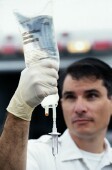
TUESDAY, March 20 (HealthDay News) — The decades-old practice of treating cardiac arrest patients with epinephrine — adrenaline — might do more harm than good in the long run, suggests a new analysis of hundreds of thousands of cases.
Japanese researchers found that cardiac arrest patients given epinephrine were more likely to survive one month, compared with those who didn’t get the treatment. But when the investigators adjusted their figures statistically so they wouldn’t be thrown off by various factors, the patients who got epinephrine actually became less likely to survive a month.
And among those given epinephrine who did survive, only one-quarter of them were in good shape neurologically a month later, the study authors noted.
On the other hand, the patients who received the drug were more likely to have their pulses restored before they got to the hospital, according to the report published in the March 21 issue of the Journal of the American Medical Association.
Dr. Clifton Callaway, an executive vice chair of emergency medicine at the University of Pittsburgh who wrote an accompanying journal editorial, said the new findings raise questions about the routine use of the drug.
“We need to figure out why those patients aren’t doing well,” Callaway said. “It improves that likelihood that we’ll get the heartbeat back, but it looks like we’re paying a price.”
Cardiac arrest occurs when the heart fails to beat properly. It’s not the same as a heart attack, although a heart attack can lead to cardiac arrest.
Physicians and paramedics often use epinephrine in conjunction with cardioversion — the shocking of the heart with electricity — to restore the heart to its normal rhythm in patients with cardiac arrest.
Although the drug was once given directly to the heart through a long needle, that doesn’t happen anymore, Callaway said. The new study examined its use as an intravenous treatment.
The study looked at nearly 420,000 cases of cardiac arrest that occurred in Japan between 2005 and 2008 in adults. The patients were all treated by emergency personnel and taken to hospitals.
It was fairly uncommon for patients to receive epinephrine during the time period. For some of that time, emergency medical personnel who weren’t doctors couldn’t legally administer it in Japan.
When epinephrine was given to patients, the unadjusted results showed that 5.4 percent were still alive a month later, compared with 4.7 percent of those who didn’t get the treatment. This isn’t unusual, as cardiac arrest patients rarely survive.
Of those who did survive and had received epinephrine, only 25 percent did well neurologically. That’s substantially lower than in patients who didn’t receive epinephrine in other studies, the researchers wrote.
“This finding implies that epinephrine administration might save the heart but not the brain,” study lead author Dr. Akihito Hagihara, a professor in the department of health services, management and policy at Kyushu University Graduate School of Medicine in Fukuoka City, and colleagues wrote.
Previous research has linked epinephrine to irregular heartbeats, disruptions in the functioning of the heart and disrupted circulation in the brain, Hagihara pointed out. “Negative effects might be due to these,” he said.
Hagihara suggested that it’s not time to abandon epinephrine entirely because the study findings still need to be verified.
While the study found an association between epinephrine for cardiac arrest and poor survival and neurological outcomes, it did not prove a cause-and-effect relationship.
More information
For more about cardiac arrest, visit the U.S. National Library of Medicine.

